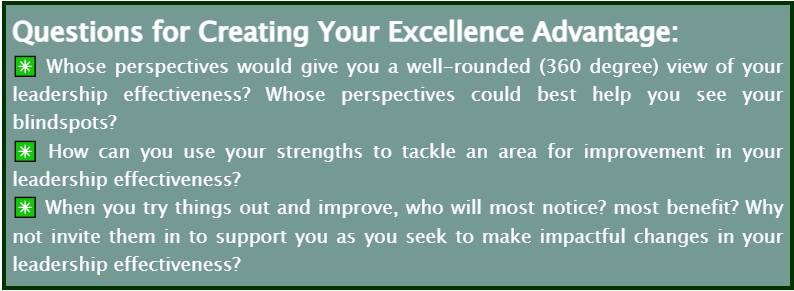Your Story From a 360° Perspective
This article is the second in a series. In Identifying your Focus Area, I identified a number of considerations for honing in on your personal focus area for leadership growth and improvement.
Every excellent leader is routinely assessing how they can improve their effectiveness and impact. They are not satisfied with good enough.
Leaders thoughtfully select where to dedicate their scarce resources of time, budget, and mental & emotional energy to the one or two areas that will have the best impact on their organizational goals, strategic priorities, and professional achievements for the year.
Alignment With Your Organizational Priorities
In the first article, I highlighted the vital, but often overlooked, importance of ensuring that your leadership development plan is directly linked to your most significant organizational priorities for the year. In my decades of experience, this alignment is an accelerant. Without alignment we find ourselves needing to make tradeoffs. With alignment, things are more in sync and flow.
Importance of a 360° Perspective
Another important consideration in selecting your area of focus for improved leadership effectiveness is a 360 degree perspective.

Without a broader perspective, we risk selecting an area for personal improvement that is not viewed as important by those we lead or those we work with most closely. We might have a blind spot that others can graciously help us to see.
The Best Methods for 360°
When working with leaders, I use the best combination of 360° methods for the situation at hand. Often it includes an interview-based 360° and/or a 360° assessment tool that is selected for the particular job role, organization culture, and informed by the reason the leader (or HR, their boss, or their Board) has reached out to me for support.
Beyond selecting a good 360° method, the thoughtful selection of a wide range of respondents is essential. They give us the 360 degrees of perspective to see our impact, habits, leadership approaches, and often highlight a range of areas for improvement.
The leader should complete their own self-assessment first prior to seeing themes from others. The person’s direct leader is also a must in a 360° (if that is a Board, due consideration is given to how to handle that perspective).
All (or most) of the leader’s direct reports should be invited to participate in the 360°, as well as colleagues and peers. Depending on the scope of the leader’s work, other considerations are key customers, or key outside collaborators, and sometimes key middle managers who can lend important (and oftentimes different) perspectives.
Finding your Story in the Data
Once gathered and anonymized (with the exception of the singular direct boss), the key is bringing it all together and finding the “story” in the 360°. What is the storyline?
Working recently with a senior leader to find her story in the 360° input, she was naturally drawn to all of her lower scores. Whereas I was able to help her to see how she could readily link her most important strategic priority to three strengths that her peers saw in her with one area for improvement that her direct reports most needed from her.
As a leader, it is important that you uncover and buy into the “story line” from the 360° input. In the example above, the leader asked for more time to comb back through her 360° themes and she did find the storyline that was clear and compelling to her.
Even if there is a mandate to change/improve, you first need to agree on what to work on improving first.
If the focus area doesn’t resonate deeply with you, then sustained change will not occur.
Before moving forward, we validate that the leader feels that the 360° perspectives informed their selection but that they personally and professionally are committed to improvement in the focus area.
Stakeholder Centered Coaching to Accelerate Progress
In prior articles, I highlighted how after a 360° assessment, some leaders chose to use Stakeholder Centered Coaching to accelerate their leadership effectiveness improvement efforts. Inviting stakeholders into the coaching process who are in the best position to benefit from or are able to see the leader’s efforts and actual improvements unfold.
These stakeholders are enlisted by the leader and the coach. They are invited to kindly and from this point forward offer “feedforward” and (very recent) “feedback” as the leader seeks to try out and make the improvements they have committed to in order to be a more effective leader.

If you’d like to receive these Inspirations in your inbox every other week, you can subscribe to Kathy’s Excellence Advantage Inspirations Newsletter.
Kathy Letendre, President and Founder of Letendre & Associates, advises organizations and leaders to create their excellence advantage.
Contact Kathy by phone or text at 802-779-4315 or via email.

